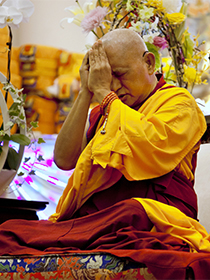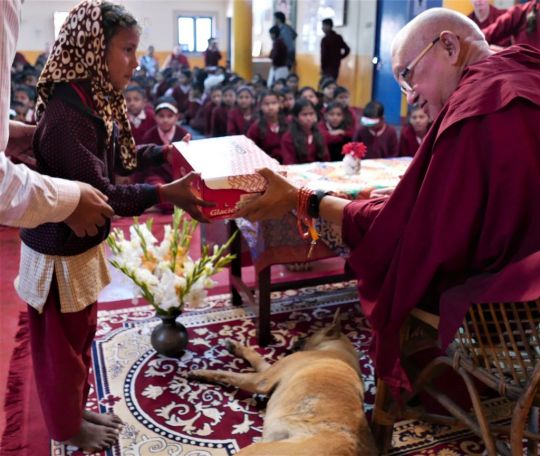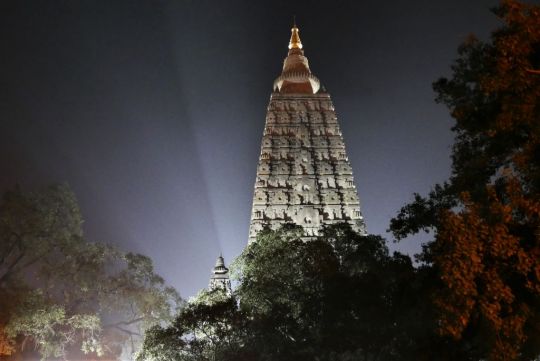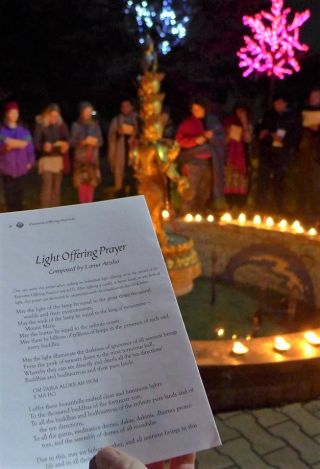- Home
- FPMT Homepage
Foundation for the Preservation of the Mahayana Tradition
The FPMT is an organization devoted to preserving and spreading Mahayana Buddhism worldwide by creating opportunities to listen, reflect, meditate, practice and actualize the unmistaken teachings of the Buddha and based on that experience spreading the Dharma to sentient beings. We provide integrated education through which people’s minds and hearts can be transformed into their highest potential for the benefit of others, inspired by an attitude of universal responsibility and service. We are committed to creating harmonious environments and helping all beings develop their full potential of infinite wisdom and compassion. Our organization is based on the Buddhist tradition of Lama Tsongkhapa of Tibet as taught to us by our founders Lama Thubten Yeshe and Lama Thubten Zopa Rinpoche.
- Willkommen
Die Stiftung zur Erhaltung der Mahayana Tradition (FPMT) ist eine Organisation, die sich weltweit für die Erhaltung und Verbreitung des Mahayana-Buddhismus einsetzt, indem sie Möglichkeiten schafft, den makellosen Lehren des Buddha zuzuhören, über sie zur reflektieren und zu meditieren und auf der Grundlage dieser Erfahrung das Dharma unter den Lebewesen zu verbreiten.
Wir bieten integrierte Schulungswege an, durch denen der Geist und das Herz der Menschen in ihr höchstes Potential verwandelt werden zum Wohl der anderen – inspiriert durch eine Haltung der universellen Verantwortung und dem Wunsch zu dienen. Wir haben uns verpflichtet, harmonische Umgebungen zu schaffen und allen Wesen zu helfen, ihr volles Potenzial unendlicher Weisheit und grenzenlosen Mitgefühls zu verwirklichen.
Unsere Organisation basiert auf der buddhistischen Tradition von Lama Tsongkhapa von Tibet, so wie sie uns von unseren Gründern Lama Thubten Yeshe und Lama Thubten Zopa Rinpoche gelehrt wird.
- Bienvenidos
La Fundación para la preservación de la tradición Mahayana (FPMT) es una organización que se dedica a preservar y difundir el budismo Mahayana en todo el mundo, creando oportunidades para escuchar, reflexionar, meditar, practicar y actualizar las enseñanzas inconfundibles de Buda y en base a esa experiencia difundir el Dharma a los seres.
Proporcionamos una educación integrada a través de la cual las mentes y los corazones de las personas se pueden transformar en su mayor potencial para el beneficio de los demás, inspirados por una actitud de responsabilidad y servicio universales. Estamos comprometidos a crear ambientes armoniosos y ayudar a todos los seres a desarrollar todo su potencial de infinita sabiduría y compasión.
Nuestra organización se basa en la tradición budista de Lama Tsongkhapa del Tíbet como nos lo enseñaron nuestros fundadores Lama Thubten Yeshe y Lama Zopa Rinpoche.
A continuación puede ver una lista de los centros y sus páginas web en su lengua preferida.
- Bienvenue
L’organisation de la FPMT a pour vocation la préservation et la diffusion du bouddhisme du mahayana dans le monde entier. Elle offre l’opportunité d’écouter, de réfléchir, de méditer, de pratiquer et de réaliser les enseignements excellents du Bouddha, pour ensuite transmettre le Dharma à tous les êtres. Nous proposons une formation intégrée grâce à laquelle le cœur et l’esprit de chacun peuvent accomplir leur potentiel le plus élevé pour le bien d’autrui, inspirés par le sens du service et une responsabilité universelle. Nous nous engageons à créer un environnement harmonieux et à aider tous les êtres à épanouir leur potentiel illimité de compassion et de sagesse. Notre organisation s’appuie sur la tradition guéloukpa de Lama Tsongkhapa du Tibet, telle qu’elle a été enseignée par nos fondateurs Lama Thoubtèn Yéshé et Lama Zopa Rinpoché.
Visitez le site de notre Editions Mahayana pour les traductions, conseils et nouvelles du Bureau international en français.
Voici une liste de centres et de leurs sites dans votre langue préférée
- Benvenuto
L’FPMT è un organizzazione il cui scopo è preservare e diffondere il Buddhismo Mahayana nel mondo, creando occasioni di ascolto, riflessione, meditazione e pratica dei perfetti insegnamenti del Buddha, al fine di attualizzare e diffondere il Dharma fra tutti gli esseri senzienti.
Offriamo un’educazione integrata, che può trasformare la mente e i cuori delle persone nel loro massimo potenziale, per il beneficio di tutti gli esseri, ispirati da un’attitudine di responsabilità universale e di servizio.
Il nostro obiettivo è quello di creare contesti armoniosi e aiutare tutti gli esseri a sviluppare in modo completo le proprie potenzialità di infinita saggezza e compassione.
La nostra organizzazione si basa sulla tradizione buddhista di Lama Tsongkhapa del Tibet, così come ci è stata insegnata dai nostri fondatori Lama Thubten Yeshe e Lama Zopa Rinpoche.
Di seguito potete trovare un elenco dei centri e dei loro siti nella lingua da voi prescelta.
- 欢迎 / 歡迎
简体中文
“护持大乘法脉基金会”( 英文简称:FPMT。全名:Foundation for the Preservation of the Mahayana Tradition) 是一个致力于护持和弘扬大乘佛法的国际佛教组织。我们提供听闻,思维,禅修,修行和实证佛陀无误教法的机会,以便让一切众生都能够享受佛法的指引和滋润。
我们全力创造和谐融洽的环境, 为人们提供解行并重的完整佛法教育,以便启发内在的环宇悲心及责任心,并开发内心所蕴藏的巨大潜能 — 无限的智慧与悲心 — 以便利益和服务一切有情。
FPMT的创办人是图腾耶喜喇嘛和喇嘛梭巴仁波切。我们所修习的是由两位上师所教导的,西藏喀巴大师的佛法传承。
繁體中文
護持大乘法脈基金會”( 英文簡稱:FPMT。全名:Found
ation for the Preservation of the Mahayana Tradition ) 是一個致力於護持和弘揚大乘佛法的國際佛教組織。我們提供聽聞, 思維,禪修,修行和實證佛陀無誤教法的機會,以便讓一切眾生都能 夠享受佛法的指引和滋潤。 我們全力創造和諧融洽的環境,
為人們提供解行並重的完整佛法教育,以便啟發內在的環宇悲心及責 任心,並開發內心所蘊藏的巨大潛能 — 無限的智慧與悲心 – – 以便利益和服務一切有情。 FPMT的創辦人是圖騰耶喜喇嘛和喇嘛梭巴仁波切。
我們所修習的是由兩位上師所教導的,西藏喀巴大師的佛法傳承。 察看道场信息:
- FPMT Homepage
- News/Media
-
- Study & Practice
-
-
- About FPMT Education Services
- Latest News
- Programs
- New to Buddhism?
- Buddhist Mind Science: Activating Your Potential
- Heart Advice for Death and Dying
- Discovering Buddhism
- Living in the Path
- Exploring Buddhism
- FPMT Basic Program
- FPMT Masters Program
- FPMT In-Depth Meditation Training
- Maitripa College
- Lotsawa Rinchen Zangpo Translator Program
- Universal Education for Compassion & Wisdom
- Online Learning Center
-
- Prayers & Practice Materials
- Overview of Prayers & Practices
- Full Catalogue of Prayers & Practice Materials
- Explore Popular Topics
- Benefiting Animals
- Chenrezig Resources
- Death & Dying Resources
- Lama Chopa (Guru Puja)
- Lama Zopa Rinpoche: Compendium of Precious Instructions
- Lama Zopa Rinpoche: Life Practice Advice
- Lama Zopa Rinpoche Practice Series
- Lamrim Resources
- Mantras
- Prayer Book Updates
- Purification Practices
- Sutras
- Thought Transformation (Lojong)
- Audio Materials
- Dharma Dates - Tibetan Calendar
- Translation Services
- Publishing Services
- Ways to Offer Support
- Prayers & Practice Materials
-
- Teachings and Advice
- Find Teachings and Advice
- Lama Zopa Rinpoche Advice Page
- Lama Zopa Rinpoche: Compendium of Precious Instructions
- Lama Zopa Rinpoche Video Teachings
- ༧སྐྱབས་རྗེ་བཟོད་པ་རིན་པོ་ཆེ་མཆོག་ནས་སྩལ་བའི་བཀའ་སློབ་བརྙན་འཕྲིན།
- Podcasts
- Lama Yeshe Wisdom Archive
- Buddhism FAQ
- Dharma for Young People
- Resources on Holy Objects
- Teachings and Advice
-
-
*If a menu item has a submenu clicking once will expand the menu clicking twice will open the page.
-
-
- Centers
-
- Teachers
-
- Projects
-
-
-
-
*If a menu item has a submenu clicking once will expand the menu clicking twice will open the page.
-
-
- FPMT
-
-
-
-
-
When you recognize your problem comes from your concept or your concept is the problem, you don’t blame others.
Lama Zopa Rinpoche
-
-
-
- Shop
-
-
-
The Foundation Store is FPMT’s online shop and features a vast selection of Buddhist study and practice materials written or recommended by our lineage gurus. These items include homestudy programs, prayers and practices in PDF or eBook format, materials for children, and other resources to support practitioners.
Items displayed in the shop are made available for Dharma practice and educational purposes, and never for the purpose of profiting from their sale. Please read FPMT Foundation Store Policy Regarding Dharma Items for more information.
-
-
Lama Zopa Rinpoche News
6
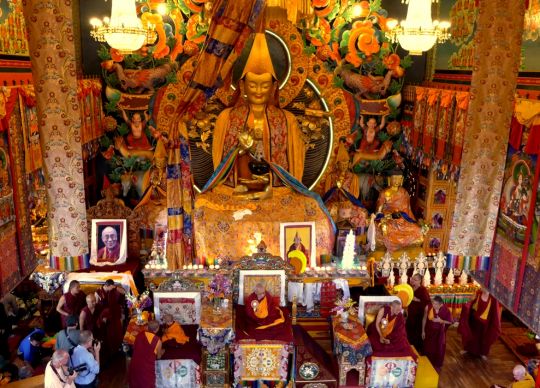
Preparing for the enthronement: Thubten Rigsel Rinpoche, Lama Zopa Rinpoche, and Khen Rinpoche Geshe Chonyi at the beginning of the ceremony, Kopan Monastery, Nepal, March 6, 2017. Photo by Laura Miller.
Monday March 6—today—is the start of the enthronement celebrations for the reincarnation of Kopan Monastery’s beloved long-time abbot, Khensur Rinpoche Lama Lhundrup. The official enthronement of Thubten Rigsel Rinpoche took place this morning (Nepal time) in the main Kopan gompa, festooned for the occasion and presided over by Lama Zopa Rinpoche and other lamas.
Khensur Rinpoche Lama Lhundrup arrived at Kopan Monastery in 1973. He was “mother, father, teacher, friend” to the monks and nuns of Kopan, as well as to many Western and Asian students, and he oversaw the growth and development of the monastery and nunnery for almost forty years until his passing in 2011.
Monks from Kopan’s tantric college began the auspicious day, blowing their long horns in the early morning. Then Khen Rinpoche Geshe Chonyi, Kopan’s current abbot, and others escorted the young Tenzin Rigsel Rinpoche up to Lama Zopa Rinpoche’s room for the hair cutting ceremony, when his name was changed to Thubten Rigsel Rinpoche.
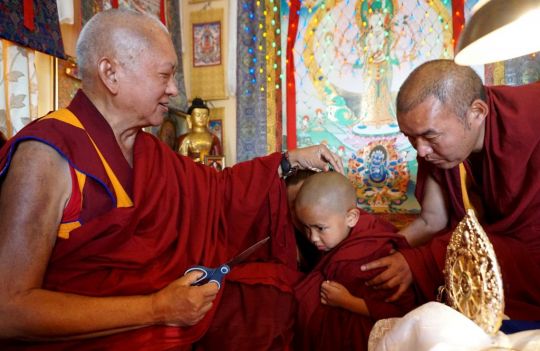
The hair cutting ceremony, Kopan Monastery, Nepal, March 6, 2017. Photo by Ven. Lobsang Sherab.
Morning prayers were followed by the enthronement ceremony itself.
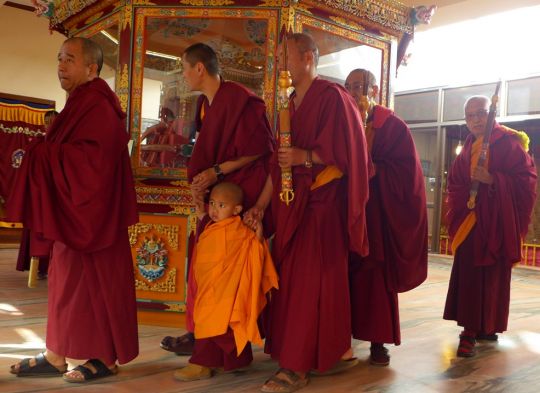
Thubten Rigsel Rinpoche attends morning prayers before the ceremony with, left to right, Losang Namgyal Rinpoche, Ven. Ngodrup Tsering, Ven. Thubten Kunkhen (Khensur Lama Lhundrub’s attendant), Khen Rinpoche Geshe Chonyi, and Lama Zopa Rinpoche, Kopan Monastery, March 6, 2017. Photo by Laura Miller.
After the ceremony, there was a long khata offering line for Lama Zopa Rinpoche, Thubten Rigsel Rinpoche, and Khen Rinpoche. Many other lamas attended the ceremony, including Yangsi Rinpoche, president of Maitripa College; Tenzin Phuntsok Rinpoche, the reincarnation of Geshe Lama Konchog; Kundol Rinpoche; Cherok Lama Rinpoche; Lama Monlam; the manager of Sera Je Monastery; the manager of Tsawa Khangsten at Sera Je; and representatives from the fifteen Gelug monasteries in Kathmandu, Nepal.
About 300 invited guests are staying at Kopan Monastery and Nunnery for the event, and more than a thousand came for the ceremony. These included large groups from Singapore, Malaysia, and Hong Kong; approximately fifteen IMI Sangha; ten FPMT center directors; and Mandala’s managing editor Laura Miller. The parents of Thubten Rigsel Rinpoche, who is the younger brother of Tenzin Phuntsok Rinpoche, came from Tsum, a remote valley area of Nepal; many Tsumpas (people from Tsum) also attended.
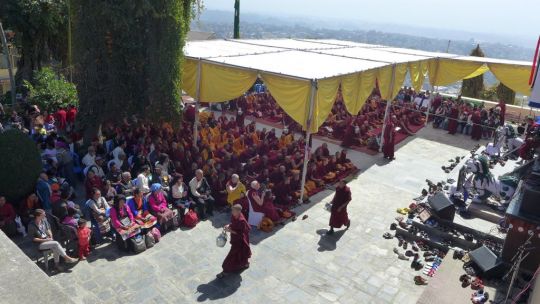
With so many attendees, some people had to sit in the courtyard. A group of Tsumpas sit on the left. Kopan Monastery, Nepal, March 6, 2107. Photo by Laura Miller.
After the ceremony, lunch was offered to all, with Kopan’s Enlightenment Garden transformed into a beautiful dining area.
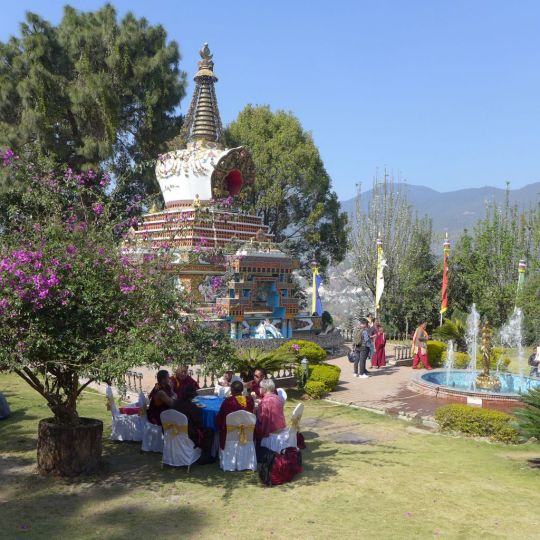
Lunch in the Enlightenment Garden, Kopan Monastery, Nepal, March 6, 2017. Photo by Laura Miller.
In the afternoon, there was an offering of songs and dances in the courtyard in front of the gompa, including performances by singers and dancers and lama dances by Kopan monks.
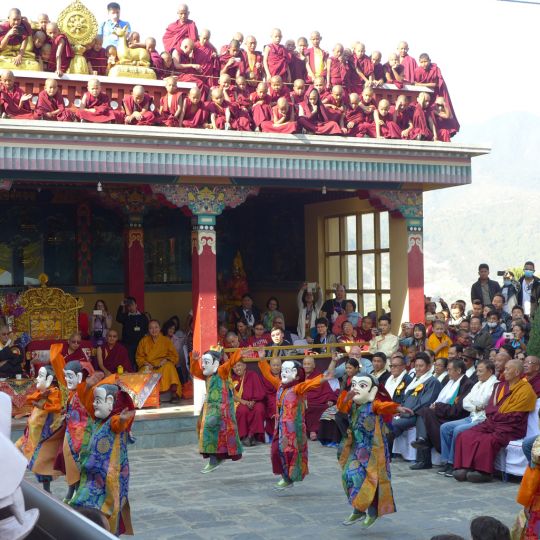
Young monks dancing during the celebrations, Kopan Monastery, Nepal, March 6, 2017. Photo by Laura Miller.
The entire enthronement celebration will run for three days and include a long life initiation offered by Lama Zopa Rinpoche, the arrival of His Eminence Jangtse Chöje Rinpoche Lobsang Tenzin, a pilgrimage to Swayambu Stupa, and a special dinner at the Hyatt Hotel.
Lama Zopa Rinpoche is the spiritual director of the Foundation for the Preservation of Mahayana Tradition (FPMT), a Tibetan Buddhist organization dedicated to the transmission of the Mahayana Buddhist tradition and values worldwide through teaching, meditation and community service.
27
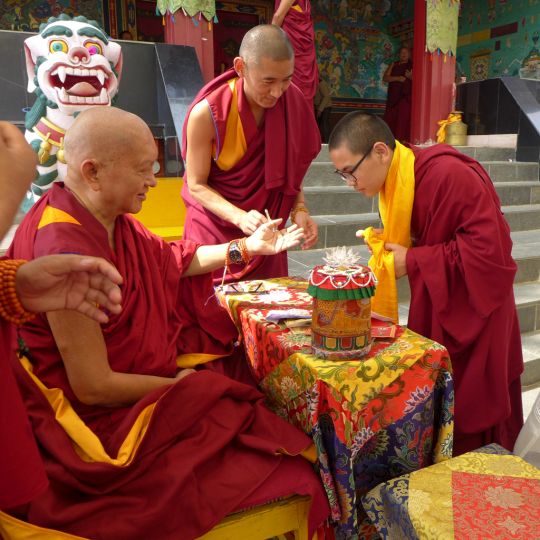
Lama Zopa Rinpoche with Tenzin Phuntsok Rinpoche, who has just offered a khata, Losar celebrations, Kopan Monastery, Nepal, February 2017. Photo by Laura Miller.
Lama Zopa Rinpoche arrived the night of February 25 at Kopan Monastery in Nepal to join in the Losar (Tibetan New Year) celebrations there. He had traveled from Tushita Meditation Centre in Dharamsala, India, where he visited briefly. On his arrival at Kopan, monks lined up with khatas to welcome him, and he was also offered khatas by Tenzin Phuntsok Rinpoche, the reincarnation of Kopan’s beloved Geshe Lama Konchog, who had recently arrived from Sera Je Monastery; Western Sangha members; and Western students participating in Kopan’s three-month Vajrasattva retreat.
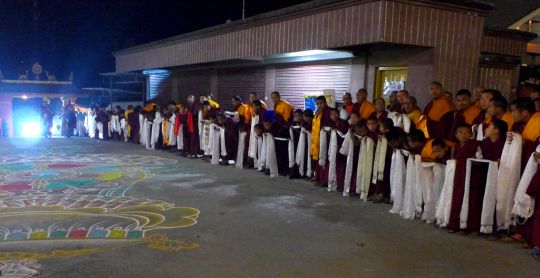
Waiting to welcome Lama Zopa Rinpoche to Kopan Monastery, Nepal, February 25, 2017. Photo by Laura Miller.
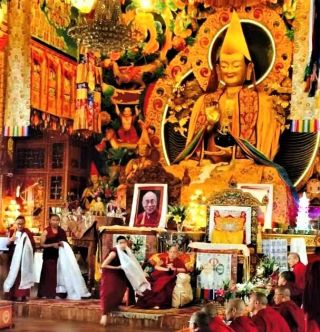
Lama Zopa Rinpoche congratulating monks from Kopan Monastery School, February 2017. Photo from Kopan Monastery School via Facebook.
On Sunday, February 26, Kopan Monastery School had its year-end ceremony and celebration, during which exam results were announced and the monks received recognition and awards for their performance during the 2016-7 school year. Lama Zopa Rinpoche attended as well as Kopan’s abbot Khen Rinpoche Geshe Thubten Chonyi. Rinpoche spoke to the monks, reminding them how fortunate they were to study the monastic texts and offering them encouragement to work hard on their studies.
Lama Zopa Rinpoche attended Lama Chöpa tsog on the morning of Losar, celebrating the beginning of the new year with all the Kopan monks and nuns. Rinpoche gave a talk to the monks and nuns in Tibetan during the puja.
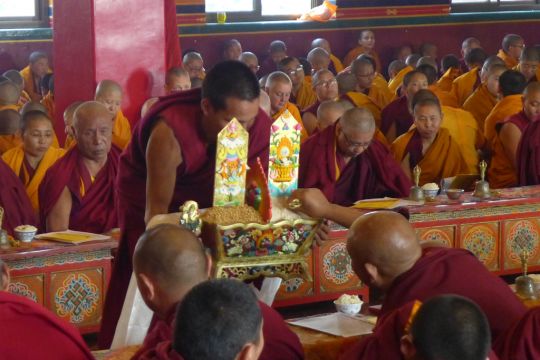
At Lama Chöpa puja, Losar celebrations, Kopan Monastery, Nepal, February 2017. Photo by Laura Miller.
After the puja, khatas were offered to the rinpoches attending the puja and Kopan’s abbot. Then a big community picnic lunch followed. Tenzin Rigsel Rinpoche, Khensur Rinpoche Lama Lhundrup’s reincarnation, who will be enthroned next week at Kopan, also attended the picnic.
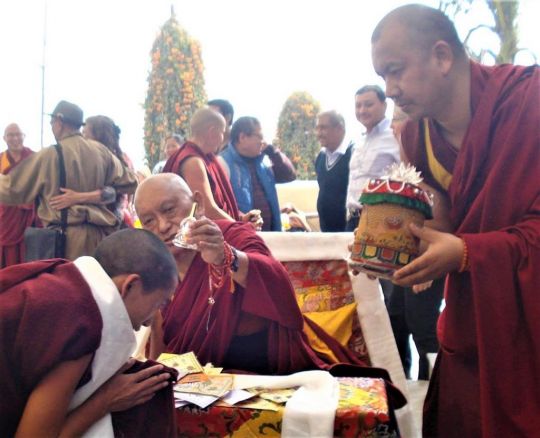
Lama Zopa Rinpoche blesses Kopan’s monks and nuns after the picnic, Losar celebrations, February 2017, Nepal. Photo by Bijaya R. Tuladhar via Facebook.
Lama Zopa Rinpoche and everyone at FPMT International Office wish all of our readers a big Losar Tashi Delek—Happy Tibetan New Year—to all!
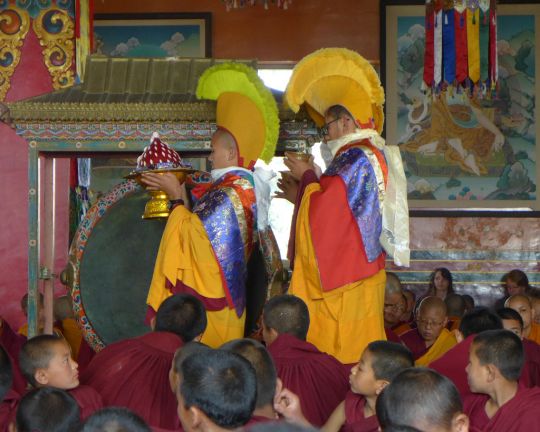
Lama Chöpa offerings at Losar, Kopan Monastery, Nepal, February 2017. Photo by Laura Miller.
Lama Zopa Rinpoche is the spiritual director of the Foundation for the Preservation of Mahayana Tradition (FPMT), a Tibetan Buddhist organization dedicated to the transmission of the Mahayana Buddhist tradition and values worldwide through teaching, meditation and community service.
- Tagged: kopan monastery, kopan monastery school, lama zopa rinpoche, losar, tenzin phuntsok rinpoche
- 0
20
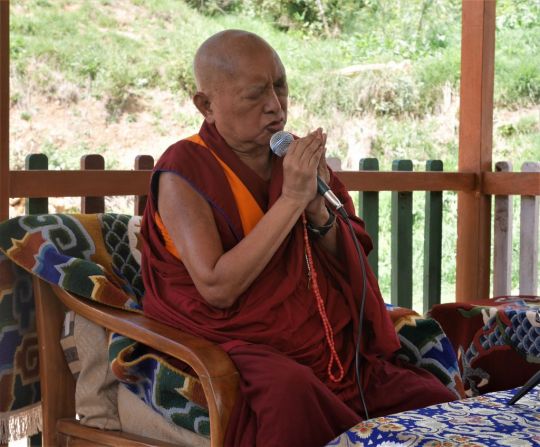
Lama Zopa Rinpoche chants blessings to rescued dogs in Bhutan, July 2016. Photo by Ven. Holly Ansett.
In 2016, Lama Zopa Rinpoche heard about a service that rescues stray dogs in Malaysia, and that had cared for more than a thousand of them. He was deeply touched to hear about this rescue effort.
Rinpoche wanted to make an offering of food to help the dogs and also support the woman who ran the rescue service. The local FPMT center, Losang Dragapa Centre, raised money and Rinpoche also contributed. Together, they offered enough money for six months’ worth of food. In addition, Rinpoche asked the center members to put Namgyalma mantras on the ceilings of each of the kennels where the rescued dogs stayed, which they did. Because of this, the dogs now receive purification and blessings from the mantra.
Afterward, Rinpoche sent the center the following letter of thanks.
My most dear, most precious, most kind wish-fulfilling one and everyone,
Thank you very, very much billion, zillion, trillion times, to all the students and all the friends. Please tell everyone my billion, zillion, trillion on and on thanks for the support for the dogs.
Buddha said:
Any sentient being, who during the period of my teachings,
Makes charity well (even if the material is the size of hair)
For 80,000 eons there will be great result of great enjoyment.
No pain, no disease, and enjoyment of happiness.
Like that, one will be enriched with desirable things.
At the end you can actually achieve the result—the peerless cessation and completion (enlightenment)
After hearing that there is the great result—who wouldn’t want to collect merit?
Please pass on this quote and my thanks to everyone. Also please give it to the lady who has the dogs, telling her it is from me.
With much love and prayers,
Lama Zopa Rinpoche
Transcribed by Ven. Holly Ansett. Lightly edited by Ven. Holly Ansett and Mandala.
Benefiting animals is one of Lama Zopa Rinpoche’s Vast Visions for FPMT:
https://fpmt.org/fpmt/vast-vision/#animals
Watch a short video about the benefits of the Namgyalma mantra:
https://fpmt.org/mandala-today/the-benefits-of-the-namgyalma-mantra-video/
For more about FPMT’s activities to benefit animals see:
https://fpmt.org/tag/animals/
Lama Zopa Rinpoche is the spiritual director of the Foundation for the Preservation of Mahayana Tradition (FPMT), a Tibetan Buddhist organization dedicated to the transmission of the Mahayana Buddhist tradition and values worldwide through teaching, meditation and community service.
- Tagged: animals, lama zopa rinpoche, namgyalma mantra
- 0
15
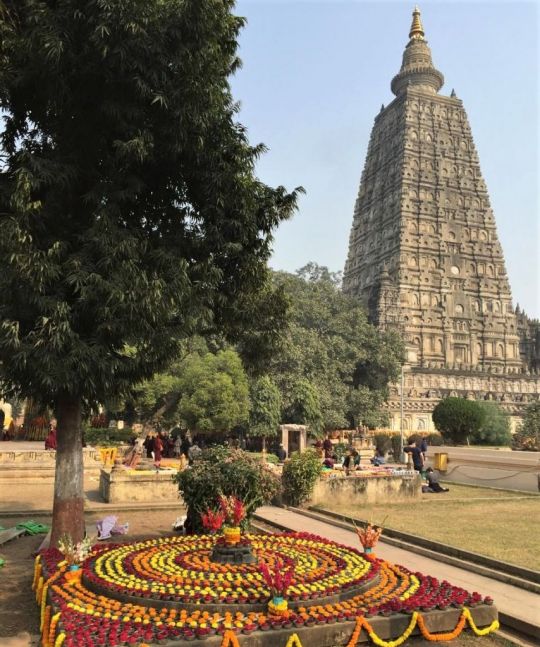
Mahabodhi Stupa, Bodhgaya, India, January 2017. Photo by Jane Seidlitz. Lama Zopa Rinpoche led groups of students to circumambulate this stupa many times while he was in Bodhgaya.
During his recent travels in Nepal and India, Lama Zopa Rinpoche visited stupas over and over.
In the book, Benefits and Practices Related to Statues and Stupas, he explains why: “Every day, when sentient beings see stupas and statues, this plants the seed of enlightenment. It is said that even dreaming of a stupa plants the seed of enlightenment.”
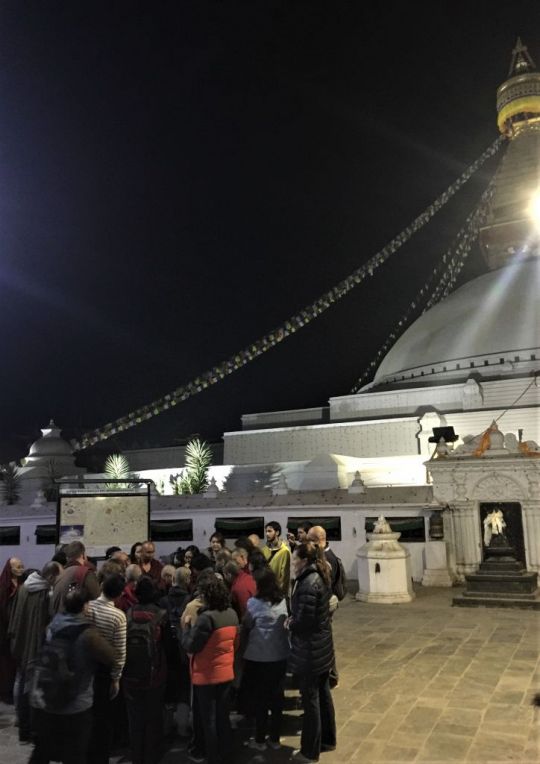
Lama Zopa Rinpoche teaching on how to circumambulate a stupa, Boudhanath Stupa, Nepal, December 2016. Photo by Ven. Roger Kunsang.
He adds: “Enlightenment doesn’t happen by a click of the fingers; but seeing holy objects plants the imprint to actualize the path and achieve enlightenment. Once you have holy objects, then every day they work for sentient beings, naturally, all the time. For beings such as animals or insects who merely touch a stupa with mantras inside—even if they are touched by just the shadow of the stupa—the negative karma in their minds of having killed their father or mother is purified. When water or rain touches the stupa, it becomes holy water. The rainwater that touches the stupa becomes blessed. So when it rains and the rainwater runs from the stupa and soaks into the ground, any insects, worms, any being living in the ground—whomever it touches—all their negative karma gets purified. They receive a higher rebirth and become liberated. It is the same with the wind. When the wind blows over and touches a stupa, it becomes blessed and then has the power to purify. When the wind then touches sentient beings—whomever it touches, animals or flies or insects or human beings—it purifies their negative karma … It is so unbelievably powerful!”
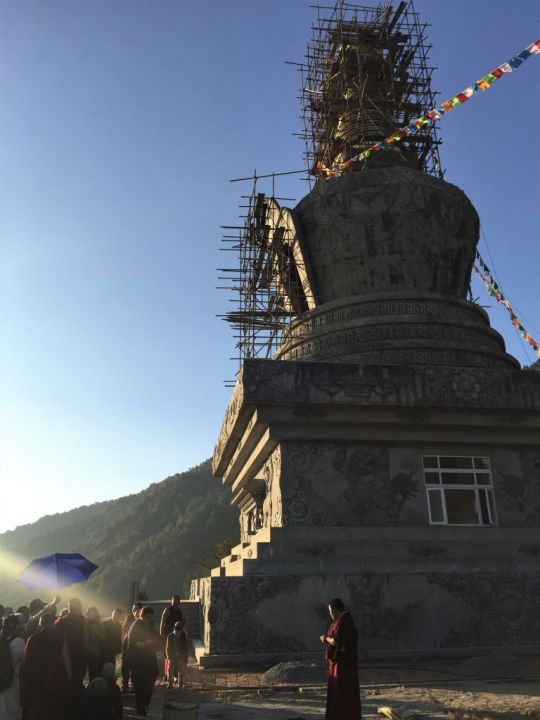
Lama Zopa Rinpoche and others visiting the stupa (under construction) of Sakya master Kyabje Chogye Trichen Rinpoche, Nepal, December 2016. Photo by Ven. Roger Kunsang.
In summary, Rinpoche teaches that the main purpose of building stupas is to make the lives of all beings, young and old, meaningful. For those who see them, stupas will:
- help purify their minds,
- help collect merit, which is the cause of all happiness and all success,
- help heal their bodies and minds through purification; and
- help to preserve Tibetan Mahayana culture.
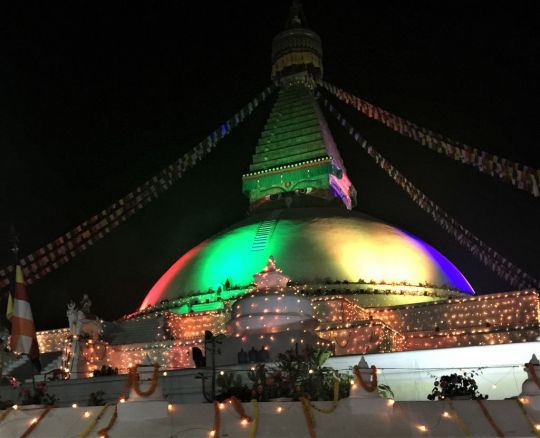
Boudhanath Stupa, Nepal, December 2016. Photo by Ven. Roger Kunsang.
To learn more about practices related to stupas, visit Stupas: A Resource Guide:
https://fpmt.org/education/practice/holy-objects/stupas-resources/.
Lama Zopa Rinpoche is the spiritual director of the Foundation for the Preservation of Mahayana Tradition (FPMT), a Tibetan Buddhist organization dedicated to the transmission of the Mahayana Buddhist tradition and values worldwide through teaching, meditation and community service.
- Tagged: boudhanath stupa, holy objects, lama zopa rinpoche, mahabodhi stupa, stupas
- 0
13
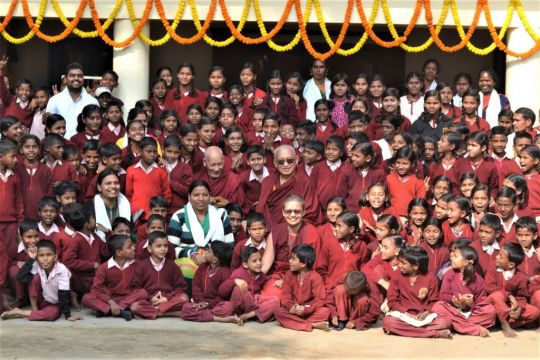
Lama Zopa Rinpoche with Maitreya School children and teachers in front of the school, Root Institute, Bodhgaya, India, January 2017. Photo by Root Institute via Facebook.
Rinpoche’s extensive activities in Bodhgaya, India, in January and February have left students overwhelmed with gratitude. Rinpoche recently left Bodhgaya, and Ven. Paldron, director of Root Institute for Wisdom Culture, the FPMT center and guesthouse in Bodhgaya, India, reports on his activities while there:
It was an honor and a privilege to have Rinpoche visit Root Institute for just over a month. Rinpoche’s kind, wise, and compassionate presence has been wonderfully healing for all of us during this time.
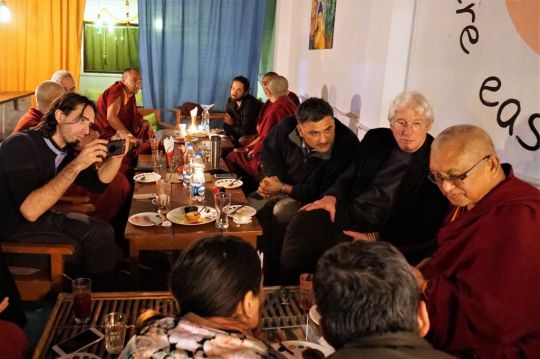
Lama Zopa Rinpoche dines with dignitaries, including Tenzin Ösel Hita and Richard Gere, Bodhgaya, India, January 2017. Photo by Ven. Lobsang Sherab.
During the two weeks of Kalachakra teachings and initiations from His Holiness the Dalai Lama, Rinpoche gave his time and energy without reservation to attend to the needs of visitors from around the world. He also visited with many lamas and dignitaries, and kindly found time to circumambulate the Mahabodhi Stupa with students on several occasions.
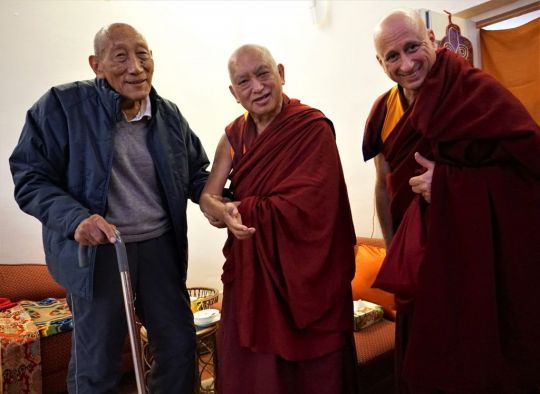
Khongla Rato Rinpoche (one of Lama Zopa Rinpoche’s gurus), Lama Zopa Rinpoche, and Khen Rinpoche Nicholas Vreeland, Bodhgaya, India, January 2017. Photo by Ven. Lobsang Sherab.
Rinpoche’s foresight had led him some time ago to request Dee Chandrashekhar, a student at Choe Khor Sum Ling in Bangalore, India, to come to Root Institute to teach the children of FPMT’s Maitreya School the Heart Sutra in Sanskrit. As a result of the students’ diligence in learning this, they had the incredible opportunity to recite it in front of His Holiness at the Kalachakra initiation. His Holiness was so pleased that he offered funds for all the children from the school to go on a picnic!
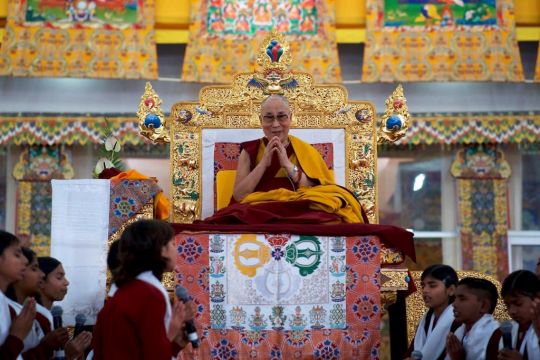
Maitreya School students recite the Heart Sutra in Sanskrit to His Holiness, Bodhgaya, India, January 2017. Photo by Bill Kane.
Due to Rinpoche’s great kindness the holy Maitreya land was blessed when Rinpoche requested the Sera Je monks to offer a long life puja there instead of at the Mahabodhi Stupa, as initially proposed. Rinpoche also advised the Kopan monks and nuns to offer Lama Chöpa tsog at the Maitreya land, thus providing immense blessings to help remove obstacles affecting the Maitreya Projects.

Long life puja for Lama Zopa Rinpoche, Maitreya Project land, Bodhgaya, India, January 2017. Photo by Ven. Lobsang Sherab.
Rinpoche kindly focused much attention on Root Institute and its projects. He blessed the Stupa Garden of Compassion first.
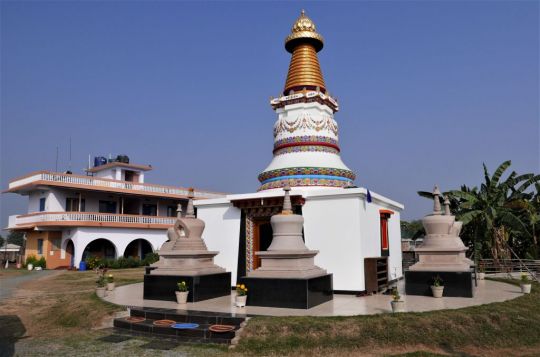
Root Institute’s new Kadampa stupa, blessed by Lama Zopa Rinpoche in January 2017. Photo by Ven. Roger Kunsang.
Then he visited with the children of Maitreya School and Tara Children’s Project, giving them an opportunity to recite the Twenty-One Tara praises in Sanskrit, and also blessing them with his holy speech. He distributed much needed shoes and socks to the children.
Rinpoche also kindly spent time at the Shakyamuni Buddha Clinic uplifting the patients with his sage advice and distributing funds and blankets to children with cerebral palsy. The staff of Root Institute, Shakyamuni Buddha Clinic, and Tara Children’s Project were all privileged to listen to Rinpoche’s teachings and advice and to offer him khatas. Our resident geshe, Lharampa Geshe Rabga, and the students of Root Institute’s Basic Program were also fortunate to receive Rinpoche’s blessings and words of wisdom.
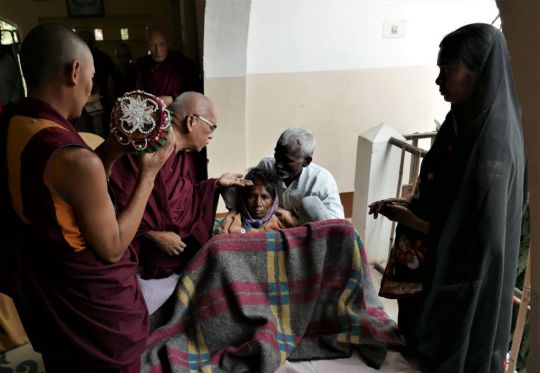
Lama Zopa Rinpoche visits a patient at Shakyamuni Buddha Clinic, Root Institute, Bodhgaya, India, January 2017. Photo by Ven. Roger Kunsang.
We at Root Institute were blessed to receive a feast of teachings from Rinpoche each day for almost two weeks—on emptiness, on the importance of guru yoga, and on the bodhichitta motivation. Rinpoche stressed over and over again the importance of serving and benefiting others and working on eliminating the self-cherishing ego.
Rinpoche also kindly bestowed a Multicolored Garuda initiation, as well as two great initiations, the Great Chenrezig and Great Medicine Buddha initiations. Thanks to a request from two Nyingma monks, we also received the White Dzambhala oral transmission. Finally, at the request of our resident geshe, Rinpoche also gave the oral transmission of the seven-point mind training composed by Geshe Chekawa, along with a commentary. We were also fortunate to offer Rinpoche Lama Chöpa tsog on two occasions in our main gompa.
We truly rejoice from the bottom of our hearts for all that we received!
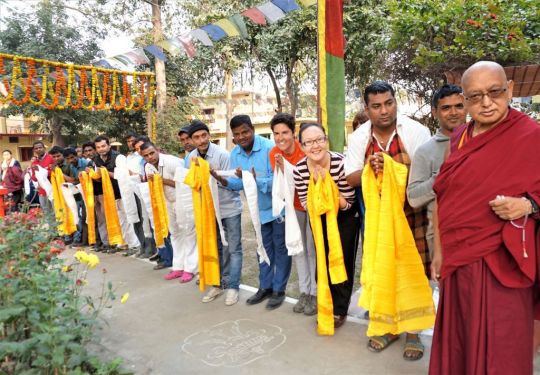
Lama Zopa Rinpoche with Root Institute workers. Bodhgaya, India, January 2017. Photo by Ven. Lobsang Sherab.
Lama Zopa Rinpoche is the spiritual director of the Foundation for the Preservation of Mahayana Tradition (FPMT), a Tibetan Buddhist organization dedicated to the transmission of the Mahayana Buddhist tradition and values worldwide through teaching, meditation and community service.
- Tagged: india, lama zopa rinpoche, root institute
- 0
8
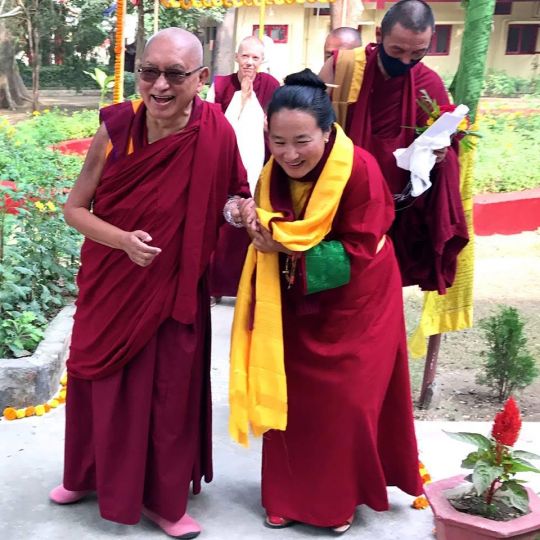
Lama Zopa Rinpoche with Khadro-la (Rangjung Neljorma Khadro Namsel Drönme) in Bodhgaya, India, January 2017. Photo by Bill Kane.
Lama Zopa Rinpoche visited some of Buddhism’s most important holy sites in January 2017, including Bodhgaya, where the Buddha attained enlightenment; Sarnath, where the Buddha gave his first teaching; and the ruins of the ancient Buddhist university of Nalanda, where many of the great Buddhist teachers of the past studied, such as Nagarjuna, Aryadeva, Chandrakirti, Shantideva, and Atisha. Nalanda is also considered to be the place of the birth and nirvana of Shariputra, a famous disciple of the Buddha.
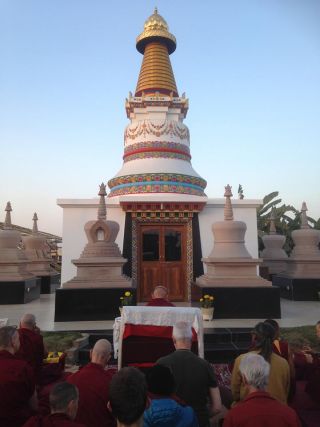
Lama Zopa Rinpoche consecrating the new Kadampa stupa at Root Institute in Bodhgaya, India, January 2017. Photo from Root Institute via Facebook.
In Bodhgaya, Rinpoche led students in circumambulating the Mahabodhi Stupa, marking the spot where the Buddha is said to have attained enlightenment, and consecrated the very beautiful new Kadampa stupa in the Stupa Garden of Compassion at Root Institute for Wisdom Culture.
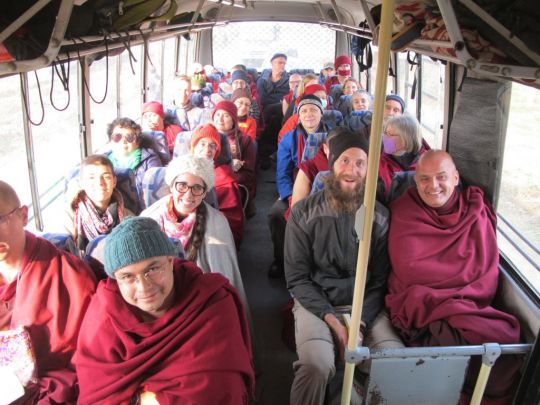
On pilgrimage with Rinpoche, India, January 2017. Photo by Jane Seidlitz.
Rinpoche invited the Kopan monks and nuns, as well as Western students staying at Root Institute, to join him on pilgrimage. Tenzin Ösel Hita; the abbot of Kopan Monastery, Khen Rinpoche Geshe Chonyi; and Kopan’s umdze (chant leader) Geshe Sherab also went on the trip to Sarnath. Several busloads of lay students, monks, and nuns accompanied Rinpoche.
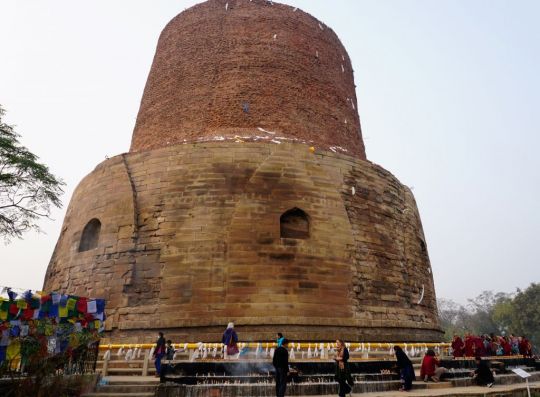
Lama Zopa Rinpoche and others circumambulating Dhamek Stupa in Sarnath, India, January 2017. Photo by Ven. Lobsang Sherab.
In Sarnath, Rinpoche led the group in circumambulating the massive Dhamek Stupa, which commemorates the Buddha having given his first teachings in the area. Rinpoche led prayers and a seven-limb practice there, and gave a short talk. He also was offered a long life puja by nuns and sponsors at Tara Temple in Sarnath, a project of Kopan Nunnery, and visited Alice Project, a school run by long-time FPMT student Valentino Giacomin.
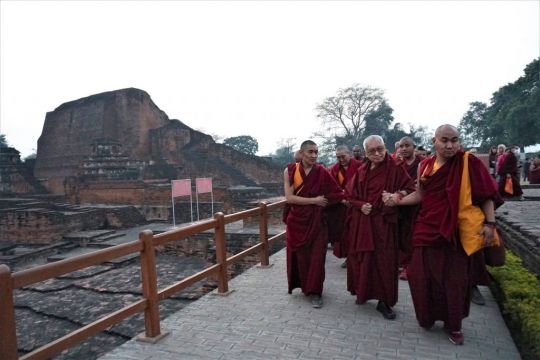
Lama Zopa Rinpoche at the ruins of the ancient Buddhist university of Nalanda. In the background is the stupa of the Buddha’s disciple Shariputra. India, January 2017. Photo by Ven. Lobsang Sherab.
While waiting for Rinpoche to arrive at Nalanda, several Kopan monks gave a demonstration of their debating skills—a very suitable pastime given that Nalanda was once a famous center for debating Buddhist philosophy.
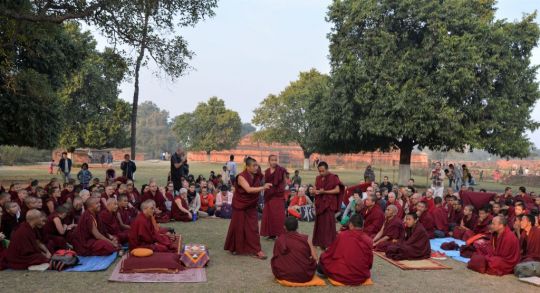
Kopan monks debate near the ruins of the ancient Buddhist university of Nalanda, India, January 2017. Photo by Kunchok Gyaltsen.
At Nalanda, Rinpoche toured the extensive ruins and gave an oral transmission from The Panchen Lama’s Debate Between Wisdom and the Reifying Habit by the renowned first Panchen Lama, Lobsang Chokyi Gyaltsen (1570-1662). In addition to several hundred people receiving this, a large group of crows gathered in the trees above, seemingly to take in the transmission!
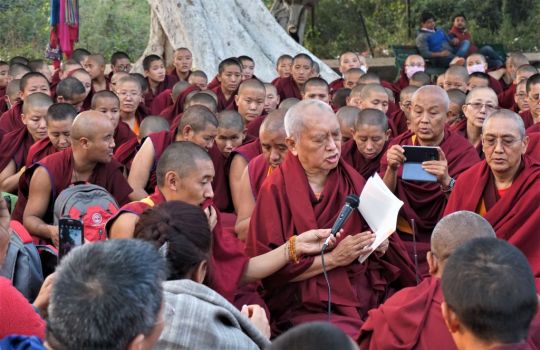
Lama Zopa Rinpoche giving an oral transmission from a Mahamudra text by Panchen Losang Chokyi Gyaltsen, Nalanda university, India, January 2017. Photo by Ven. Lobsang Sherab.
Rinpoche recommends that students go on pilgrimage to Buddhist holy places, and has given the following advice:
“Pilgrimage needs faith. The more faith, the more happiness. Otherwise, you are just like a tourist looking at ruins … When you go to these holy places it reminds you of impermanence. Once these places were great cities but now there are just stones. A thousand years ago these places were quite different. But even though there are just stones now these stones are so precious. Amazing. Can you imagine how blessed these places are? They are places where the Buddha was … So do different lam-rim prayers at these holy places and make prayers to have realizations. At the beginning do prostrations. You can recite the preliminary prayers that we do traditionally at Kopan Monastery, which include prostrations by reciting Buddha’s name. Then do the seven-limb practice. Then recite the different praises to Buddha and lam-rim prayers. If you have time, you can carry the story of the holy places with you and read that story to the people who are doing pilgrimage in the different places. If you are going on pilgrimage, read a book describing the holy places. Read about what the Buddha did in those places … “
Get the FPMT Retreat Prayer Book, containing many prayers for retreat, daily practices, and pilgrimage from the Foundation Store and support FPMT International Office:
https://shop.fpmt.org/FPMT-Retreat-Prayer-Book-PDF-_p_1371.html.
Lama Zopa Rinpoche is the spiritual director of the Foundation for the Preservation of Mahayana Tradition (FPMT), a Tibetan Buddhist organization dedicated to the transmission of the Mahayana Buddhist tradition and values worldwide through teaching, meditation and community service.
- Tagged: india, lama zopa rinpoche, pilgrimage
- 0
6
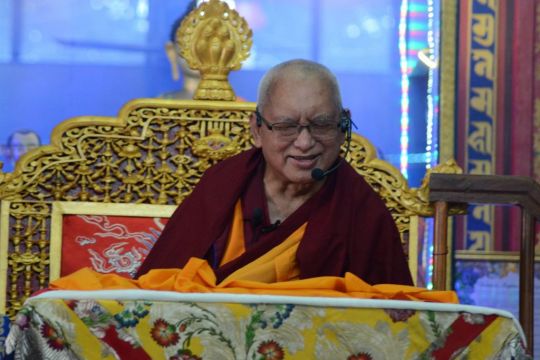
Lama Zopa Rinpoche giving a Great Chenrezig initiation, Bodhgaya, India, February 1, 2017. Photo from Root Institute for Wisdom Culture via Facebook.
Lama Zopa Rinpoche has been in Bodhgaya, India, since late December, attending the Kalachakra initiation offered by His Holiness the Dalai Lama and himself offering teachings and initiations, as well as going on pilgrimage to many of Buddhism’s holiest sites, meeting with students and other lamas, and visiting FPMT social projects: Maitreya School, Shakyamuni Buddha Clinic, and MAITRI Charitable Trust.
During the last few days of January and the first few days of February, Rinpoche gave teachings at Root Institute for Wisdom Culture and offered students a Great Chenrezig initiation and a Great Medicine Buddha initiation.
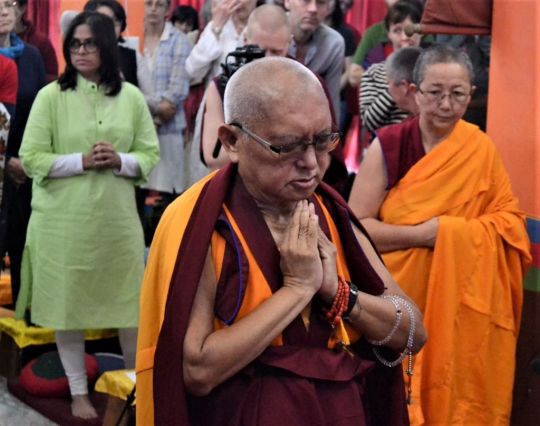
Lama Zopa Rinpoche preparing to prostrate prior to giving a Great Chenrezig initiation, Bodhgaya, India, February 1, 2017. Photo from Root Institute of Wisdom Culture via Facebook.
Rinpoche has also met with people in Bodhgaya, including His Holiness the Sakya Trizin, the supreme head of the Khon Sakya lineage and one of Rinpoche’s gurus.
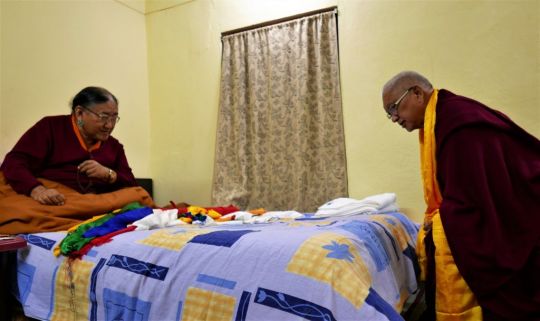
Lama Zopa Rinpoche meeting with His Holiness the Sakya Trizin, Bodhgaya, India, February 2017. Photo by Ven. Roger Kunsang.
Rinpoche also spent time with catching up with actor Richard Gere and visiting holy sites in Bodhgaya with him.
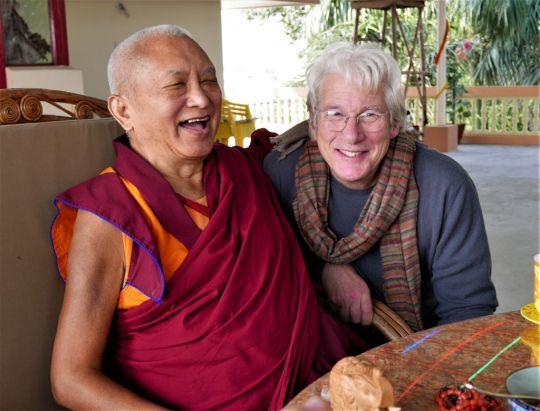
Lama Zopa Rinpoche and Richard Gere share a laugh, Bodhgaya, India, January 2017. Photo by Ven. Roger Kunsang.
Lama Zopa Rinpoche is the spiritual director of the Foundation for the Preservation of Mahayana Tradition (FPMT), a Tibetan Buddhist organization dedicated to the transmission of the Mahayana Buddhist tradition and values worldwide through teaching, meditation and community service.
1
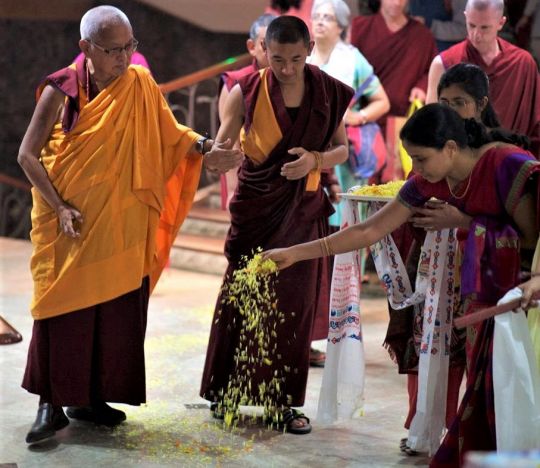
Lama Zopa Rinpoche being greeted in Bangalore, India, December 2016. Photo by Bill Kane.
Choe Khor Sum Ling (CKSL) members in Bangalore, India, are rejoicing in their recent good fortune: hosting extensive teachings by Lama Zopa Rinpoche in December 2016. About 32 FPMT Sangha and 80 lay people from around the world attended the teachings.
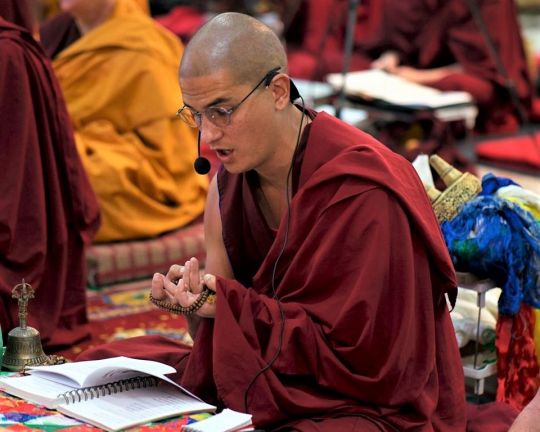
Ven. Tenzin Namjong of IMI House, Sera Je Monastery, acting as umdze (chant leader) during Rinpoche’s teachings, Bangalore, India, December 2016. Photo by Bill Kane.
Although the teachings were scheduled to be on Lama Tsongkhapa Guru Yoga, Rinpoche, seeing what would be most beneficial for the audience, taught on many of the key points of the path, including karma, the importance of motivation, the suffering nature of samsara, the Ten Innermost Jewels of the Kadampas, bodhichitta, emptiness, the importance and method of doing animal liberation practice, the meaning of the word “lama,” and how to practice the essence of guru yoga by seeing the guru as the manifestation of all the buddhas and remembering his kindness. Rinpoche also gave a White Tara long life initiation.
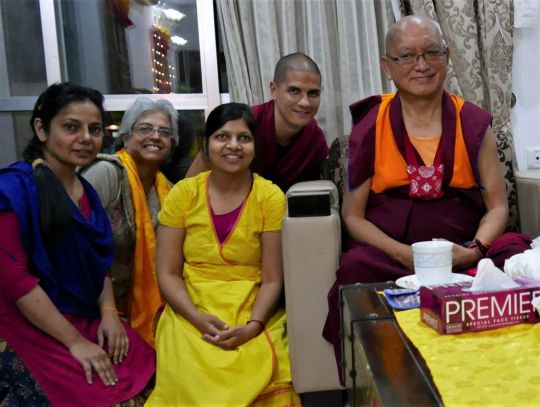
Lama Zopa Rinpoche with CKSL Center members and Ven. Tenzin Namjong, Bangalore, India, December 2016. Photo by Bill Kane.
CKSL members report on how blessed they felt on December 23, Lama Tsongkhapa Day, to be able to perform the full Lama Chöpa (Guru Puja) with tsog offering in Rinpoche’s presence. This turned into a long life puja as well when they added prayers to the Sixteen Arhats and made the traditional long life offerings to Rinpoche. In addition, for the sake of Rinpoche’s long life, Sangha and lay people attending the teachings gathered together most days and did the Sixteen Arhats puja, recited the Vajra Cutter Sutra, and recited Whita Tara and Medicine Buddha mantras.
CKSL organizers report that Rinpoche seemed pleased: the teachings were originally scheduled to be four days, but Rinpoche, through his kindness and compassion, extended them to a full ten days. He also spoke extensively about the importance of the center, giving encouragement to students to continue to do work for sentient beings and to fulfill the wishes of the guru. Rinpoche also treated the Sangha and the CKSL volunteer team to lunches and made a generous donation to CKSL’s new building project.
Rinpoche joked that although the teachings were scheduled to be on “Lama Tsongkhapa Guru Yoga,” he had only touched on the meaning of the first word, “Lama.” Rinpoche said he would try to return next year to continue. In the meantime, CKSL members expressed the hope that they could put into practice the teachings and advice they received in order to create the causes for the kind and compassionate guru to return to Bangalore to teach again and again.
The first half of Lama Zopa Rinpoche’s teachings in Bangalore can be seen on YouTube by clicking on this link: https://www.youtube.com/playlist?list=PLd3YWIA0vLx_8xqXdpEIyz-2GCVHyRi2S. The remaining teachings will also be available soon, so stay posted!
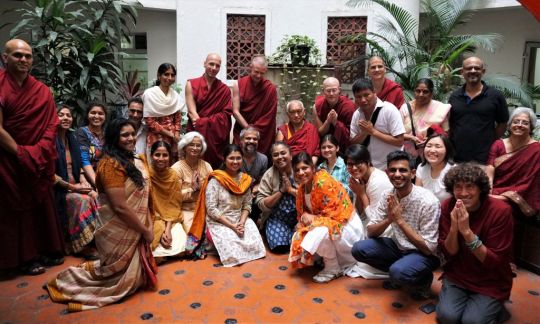
Lama Zopa Rinpoche with volunteers and staff of CKSL, Bangalore, India, December 2016. Photo by Ven. Lobsang Sherab.
With special thanks to Shanti Yajnik, Deepthy Chandrashekhar, and others at Choe Khor Sum Ling in Bangalore for reporting on this event.
Lama Zopa Rinpoche is the spiritual director of the Foundation for the Preservation of Mahayana Tradition (FPMT), a Tibetan Buddhist organization dedicated to the transmission of the Mahayana Buddhist tradition and values worldwide through teaching, meditation and community service.
- Tagged: choe khor sum ling, india, lama zopa rinpoche, teaching tours
- 0
31
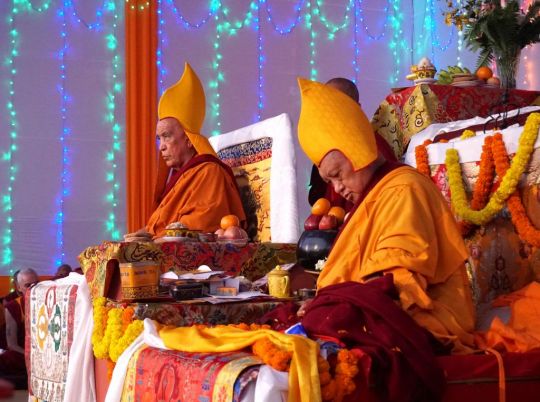
Jangtse Chöje Rinpoche and Lama Zopa Rinpoche during the long life puja offered to Lama Zopa Rinpoche in Bodhgaya on January 2, 2017. Photo by Ven. Lobsang Sherab.
A long life puja was offered to Lama Zopa Rinpoche on behalf of Sera Je Monastery on the Maitreya Project land in Bodhgaya on January 2, 2017. The puja was to thank Rinpoche for twenty-six years of support offered through the Sera Je Food Fund, which provides three vegetarian meals every day to the monks studying at Sera Je Monastery.
During the puja, the head of monastic discipline, who had been at Sera Je Monastery since before the Sera Je Food Fund was established, spontaneously praised Rinpoche for about thirty minutes, noting all the ways Rinpoche had helped the monastery. He explained what it was like at the monastery before food was regularly offered and how the monks have benefited after the fund’s creation. He said Rinpoche has cared for all the thousands of monks for the last twenty-six years like a mother does for her child.
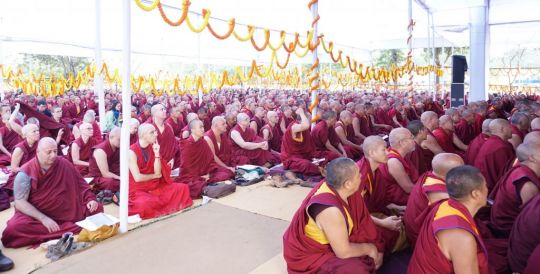
Sangha participating in the long life puja offered to Lama Zopa Rinpoche
Thousands of monks attended the puja as well as Jangtse Chöje; the new abbot of Sera Je Monastery; the past abbot of Sera Je Monastery; the past abbot of Namgyal Monastery, Jhado Rinpoche; and the past abbot of Gyurme Monastery, Khensur Geshe Tashi Tsering.
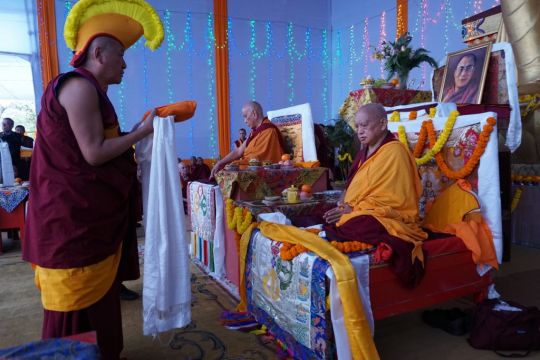
The abbot of Sera Je Monastery making offerings to Lama Zopa Rinpoche
The Sera Je Food Fund has provided millions of meals since 1991. It currently offers approximately 700,000 meals per year, 2,900 meals per day. There are, on average, 1,600 monks benefiting from the food fund.
Please rejoice in the offering of this puja for Lama Zopa Rinpoche’s long life and in Sera Je Food Fund’s twenty-six years of food offerings to the monks of Sera Je Monastery.
You can learn more about the Sera Je Food Fund, read an overview of the food offered daily, or support this project with a donation of any amount.
- Tagged: long life puja, sera je food fund, sera je monastery
- 0
25
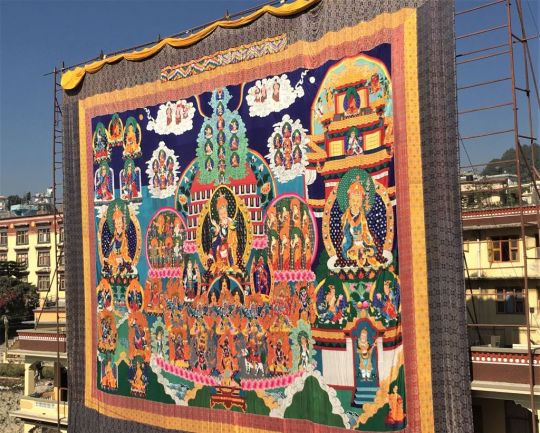
Enormous Padmasambhava thangka at Kopan Nunnery, Nepal, December 2016. Photo by Ven. Holly Ansett.
While at Kopan Monastery in Nepal in late 2016, Lama Zopa Rinpoche attended a puja at Kopan Nunnery organized by the Kopan monks and nuns, making 100,000 tsog offerings to the great Indian yogi and teacher Padmasambhava (Guru Rinpoche), who was instrumental in establishing the Dharma in Tibet.
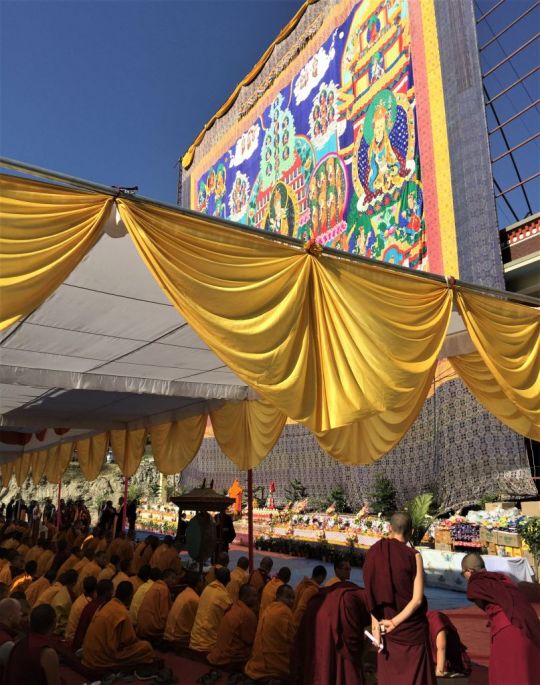
Monks and nuns perform a puja making 100,000 tsog offerings to Padmasambhava, Kopan Nunnery, Nepal, December 2016. Photo by Ven. Roger Kunsang.
The puja included the display of a gigantic Padmasambhava thangka. This thangka, made according to Lama Zopa Rinpoche’s instructions, is stitched in appliqué and is 75 feet (23 meters) high and 87 feet (27 meters) wide. Sponsored by the Lama Zopa Rinpoche Bodhichitta Fund, it took two years to create and was completed in 2013. It was then blessed by His Holiness the Dalai Lama. Lama Zopa Rinpoche attended a similar 100,000 tsog offering puja in December 2015 that was dedicated to the people of Nepal after the massive earthquake of April 2015.
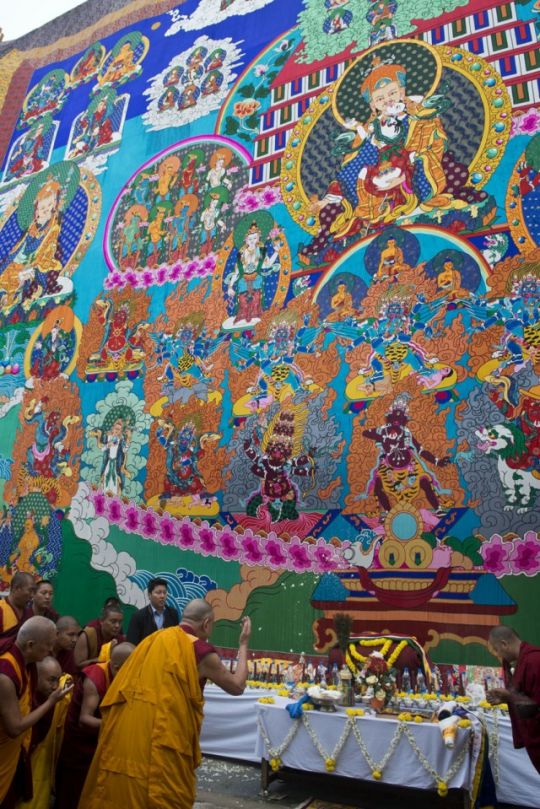
His Holiness the Dalai Lama blessing the thangka, Sera Monastery, India, December 29, 2013. Photo copyright Rio Helmi/Jangchup Lamrim Teaching Organizing Committee.
Lama Zopa Rinpoche has lauded Padmasambhava’s contributions to Buddhism and humanity: “Due to Padmasambhava’s great compassion, Tibetan Mahayana Buddhism flourished in Tibet and now has spread throughout the entire world. Because of that, so many people have experienced the path to enlightenment and achieved enlightenment. Due to his great compassion, the lives of infinite number of sentient beings have become meaningful.”
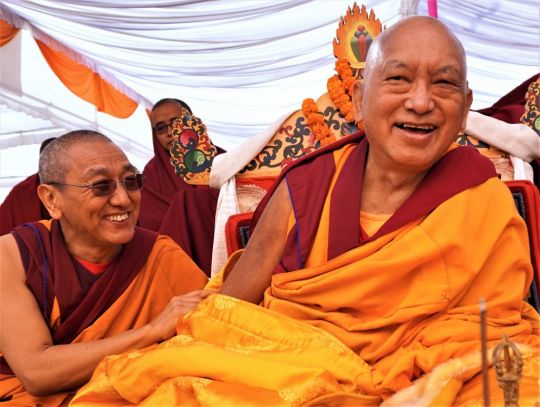
Khen Rinpoche Geshe Chonyi and Lama Zopa Rinpoche at the 100,000 tsog offerings to Guru Rinpoche puja, Kopan Nunnery, Nepal, December 2016. Photo by Ven. Lobsang Sherab.
One of Lama Zopa Rinpoche’s Vast Visions for FPMT is to create large thangkas. “My wish is for the big centers in FPMT to have these large thangkas.” Rinpoche explained. “This is a way to leave imprints for all these people [who see them], for enlightenment.”
Another of Lama Zopa Rinpoche’s Vast Visions for FPMT is to build many large statues of Padmasambhava around the world in order to create the cause for peace for all beings. The Padmasambhava Project for Peace was established to fund the creation of these statues:
https://fpmt.org/projects/fpmt/padmasambhava/
The Lama Zopa Rinpoche Bodhichitta Fund supports Rinpoche’s compassionate service to others. More information can be found at https://fpmt.org/projects/fpmt/lzrbf/.
Lama Zopa Rinpoche is the spiritual director of the Foundation for the Preservation of Mahayana Tradition (FPMT), a Tibetan Buddhist organization dedicated to the transmission of the Mahayana Buddhist tradition and values worldwide through teaching, meditation and community service.
- Tagged: guru rinpoche, khachoe ghakyil ling, kopan course 2016, lama zopa rinpoche, large thangka, padmasambhava
- 0
23

Lama Zopa Rinpoche holds up a statue of Tibetan master Thangtong Gyalpo while explaining his life story, Kopan Monastery, Nepal, December 2016. Photo by Ven. Lobsang Sherab.
While at Kopan Monastery in Nepal recently, Lama Zopa Rinpoche was shown a precious relic from the great Tibetan yogi Thangtong Gyalpo by Chusang Rinpoche, the spiritual head of Chusang Gompa, a Gelug monastery in Boudhanath, Nepal.
Chusang Rinpoche was born in Tibet in 1959 and is the son Bardok Chusang Rinpoche. The family took refuge in Nepal in the early 1960s, and the younger Rinpoche went on to become a lharampa geshe. He visited Lama Zopa Rinpoche this past December and showed him the relic, which self-emanated from a dog bone.
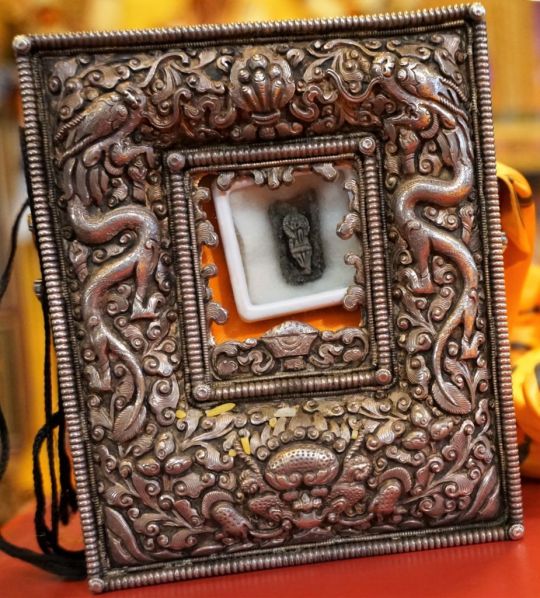
Relic from Thangtong Gyalpo, self-emanating from dog bone, Kopan Monastery, Nepal, December 2016. Photo by Ven. Lobsang Sherab.
Lama Zopa Rinpoche took the opportunity to give a talk about Thangtong Gyalpo and show students the relic.
Thangtong Gyalpo (1385–1464) was not just a great yogi but also a skilled engineer and artist, famous for building bridges across rivers to help the people of Tibet in very practical ways. He is said to have built 58 iron bridges, 60 wooden bridges, 118 ferries, 120 assembly halls and temples, 111 stupas and many hundreds of large and small statues, as well as creating innumerable paintings.
Lama Zopa Rinpoche has recommended that students of FPMT living in areas threatened by earthquakes post an image of Thangtong Gyalpo to help mitigate the effects of possible quakes.

Chusang Rinpoche, Lama Zopa Rinpoche, and Khen Rinpoche Geshe Chonyi, Kopan Monastery, Nepal, December 2016. Photo by Ven. Lobsang Sherab.
For more advice from Rinpoche on earthquakes, please see the page “Tsunami and Earthquakes”:
https://fpmt.org/teachers/zopa/advice/tsunami-and-earthquakes/
Lama Zopa Rinpoche is the spiritual director of the Foundation for the Preservation of Mahayana Tradition (FPMT), a Tibetan Buddhist organization dedicated to the transmission of the Mahayana Buddhist tradition and values worldwide through teaching, meditation and community service.
18
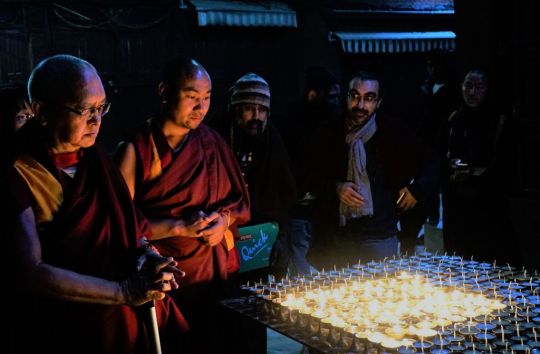
Lama Zopa Rinpoche, Boudhanath Stupa, Nepal, December, 2016. Photo by Ven. Lobsang Sherab.
“If we want to develop Dharma wisdom, then offer light.”
So said Lama Zopa Rinpoche during a teaching in Singapore in 2013. What are the results of offering lights? Rinpoche explained, “It is mentioned that if we make offerings of light or incense, do prostrations and so forth, we collect numberless great merits … By making light offerings, you are able to dispel the darkness of ignorance and achieve wisdom. By offering light, you are never in darkness while you are circling in samsara. There will always be light. And offering light just one time to Buddha creates the karma to have great wealth for many hundreds or thousands of lifetimes … [We also attain] a higher rebirth, in a pure land. We quickly achieve nirvana, and not only nirvana but also the great nirvana, enlightenment. These are the benefits of offering light.”
Rinpoche also made clear that all lights can be offered. “Many people might think if you are offering light, it should be just a butter lamp, a candle or an oil lamp. Thinking that you can’t offer the other lights in the house, for example, electric lights, is a very limited idea. Thinking that you can only offer candles is wrong. Whatever light is more clear and dispels darkness, that is the better light, so you can offer all the lights in the house.”
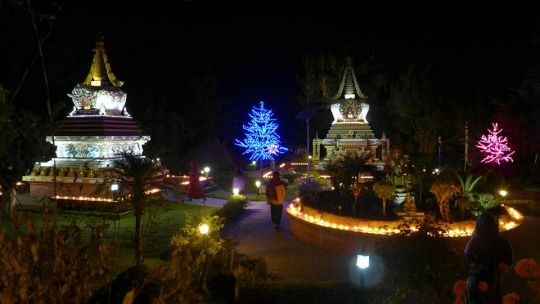
Offered lights at Kopan Monastery, Nepal, November, 2016. Photo by Laura Miller.
Read Lama Zopa Rinpoche’s teaching on light offerings in The Benefits of Making Offerings in the Lama Yeshe Wisdom Archive.
Learn more about how to make light offerings and other offerings in the book Extensive Offering Practices by Lama Zopa Rinpoche, available in The Foundation Store.
Lama Zopa Rinpoche is the spiritual director of the Foundation for the Preservation of Mahayana Tradition (FPMT), a Tibetan Buddhist organization dedicated to the transmission of the Mahayana Buddhist tradition and values worldwide through teaching, meditation and community service.
- Tagged: boudhanath stupa, lama zopa rinpoche, light offering
- 0
- Home
- News/Media
- Study & Practice
- About FPMT Education Services
- Latest News
- Programs
- New to Buddhism?
- Buddhist Mind Science: Activating Your Potential
- Heart Advice for Death and Dying
- Discovering Buddhism
- Living in the Path
- Exploring Buddhism
- FPMT Basic Program
- FPMT Masters Program
- FPMT In-Depth Meditation Training
- Maitripa College
- Lotsawa Rinchen Zangpo Translator Program
- Universal Education for Compassion & Wisdom
- Online Learning Center
- Prayers & Practice Materials
- Overview of Prayers & Practices
- Full Catalogue of Prayers & Practice Materials
- Explore Popular Topics
- Benefiting Animals
- Chenrezig Resources
- Death & Dying Resources
- Lama Chopa (Guru Puja)
- Lama Zopa Rinpoche: Compendium of Precious Instructions
- Lama Zopa Rinpoche: Life Practice Advice
- Lama Zopa Rinpoche Practice Series
- Lamrim Resources
- Mantras
- Prayer Book Updates
- Purification Practices
- Sutras
- Thought Transformation (Lojong)
- Audio Materials
- Dharma Dates – Tibetan Calendar
- Translation Services
- Publishing Services
- Teachings and Advice
- Find Teachings and Advice
- Lama Zopa Rinpoche Advice Page
- Lama Zopa Rinpoche: Compendium of Precious Instructions
- Lama Zopa Rinpoche Video Teachings
- ༧སྐྱབས་རྗེ་བཟོད་པ་རིན་པོ་ཆེ་མཆོག་ནས་སྩལ་བའི་བཀའ་སློབ་བརྙན་འཕྲིན།
- Podcasts
- Lama Yeshe Wisdom Archive
- Buddhism FAQ
- Dharma for Young People
- Resources on Holy Objects
- Ways to Offer Support
- Centers
- Affiliates Area
- Teachers
- Projects
- Charitable Projects
- Make a Donation
- Applying for Grants
- News about Projects
- Other Projects within FPMT
- Support International Office
- Projects Photo Galleries
- Give Where Most Needed
- FPMT
- Shop
Translate*
*powered by Google TranslateTranslation of pages on fpmt.org is performed by Google Translate, a third party service which FPMT has no control over. The service provides automated computer translations that are only an approximation of the websites' original content. The translations should not be considered exact and only used as a rough guide.Cherishing others opens the door to every happiness for self and others.







